engine Alfa Romeo 8C 2010 Owner handbook (in English)
[x] Cancel search | Manufacturer: ALFA ROMEO, Model Year: 2010, Model line: 8C, Model: Alfa Romeo 8C 2010Pages: 223, PDF Size: 14.35 MB
Page 5 of 223
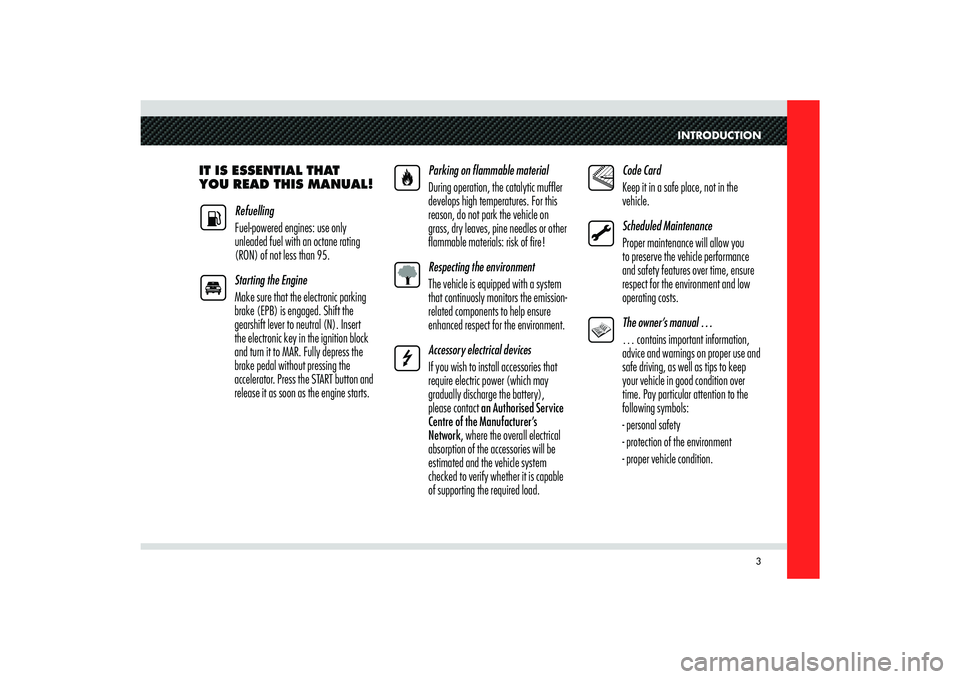
INTRODUCTION
3
IT IS ESSENTIAL THAT
YOU READ THIS MANUAL!
Refuelling
Fuel-powered engines: use only
unleaded fuel with an octane rating
(RON) of not less than 95.
Starting the Engine
Make sure that the electronic parking
brake (EPB) is engaged. Shift the
gearshift lever to neutral (N). Insert
the electronic key in the ignition block
and turn it to MAR. Fully depress the
brake pedal without pressing the
accelerator. Press the START button and
release it as soon as the engine starts.Parking on fl ammable material
During operation, the catalytic muffl er
develops high temperatures. For this
reason, do not park the vehicle on
grass, dry leaves, pine needles or other
fl ammable materials: risk of fi re!
Respecting the environment
The vehicle is equipped with a system
that continuosly monitors the emission-
related components to help ensure
enhanced respect for the environment.
Accessory electrical devices
If you wish to install accessories that
require electric power (which may
gradually discharge the battery),
please contact an Authorised Service
Centre of the Manufacturer’s
Network, where the overall electrical
absorption of the accessories will be
estimated and the vehicle system
checked to verify whether it is capable
of supporting the required load. Code Card
Keep it in a safe place, not in the
vehicle.
Scheduled Maintenance
Proper maintenance will allow you
to preserve the vehicle performance
and safety features over time, ensure
respect for the environment and low
operating costs.
The owner’s manual …
… contains important information,
advice and warnings on proper use and
safe driving, as well as tips to keep
your vehicle in good condition over
time. Pay particular attention to the
following symbols:
- personal safety
- protection of the environment
- proper vehicle condition.
Page 6 of 223
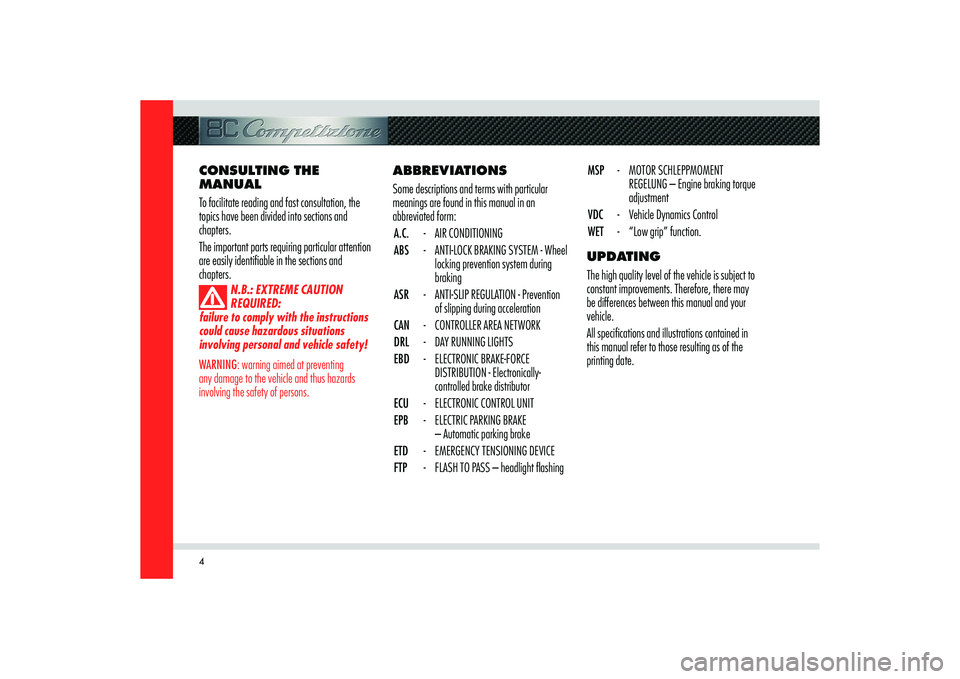
4
ABBREVIATIONS
Some descriptions and terms with particular
meanings are found in this manual in an
abbreviated form:
A.C. - AIR CONDITIONING
ABS - ANTI-LOCK BRAKING SYSTEM - Wheel
locking prevention system during
braking
ASR - ANTI-SLIP REGULATION - Prevention
of slipping during acceleration
CAN - CONTROLLER AREA NETWORK
DRL - DAY RUNNING LIGHTS
EBD - ELECTRONIC BRAKE-FORCE
DISTRIBUTION - Electronically-
controlled brake distributor
ECU - ELECTRONIC CONTROL UNIT
EPB - ELECTRIC PARKING BRAKE
– Automatic parking brake
ETD - EMERGENCY TENSIONING DEVICE
FTP - FLASH TO PASS – headlight fl ashingMSP - MOTOR SCHLEPPMOMENT
REGELUNG – Engine braking torque
adjustment
VDC - Vehicle Dynamics Control
WET - “Low grip” function.
UPDATING
The high quality level of the vehicle is subject to
constant improvements. Therefore, there may
be differences between this manual and your
vehicle.
All specifi cations and illustrations contained in
this manual refer to those resulting as of the
printing date. CONSULTING THE
MANUAL
To facilitate reading and fast consultation, the
topics have been divided into sections and
chapters.
The important parts requiring particular attention
are easily identifi able in the sections and
chapters.
N.B.: EXTREME CAUTION
REQUIRED:
failure to comply with the instructions
could cause hazardous situations
involving personal and vehicle safety!
WARNING: warning aimed at preventing
any damage to the vehicle and thus hazards
involving the safety of persons.
Page 8 of 223
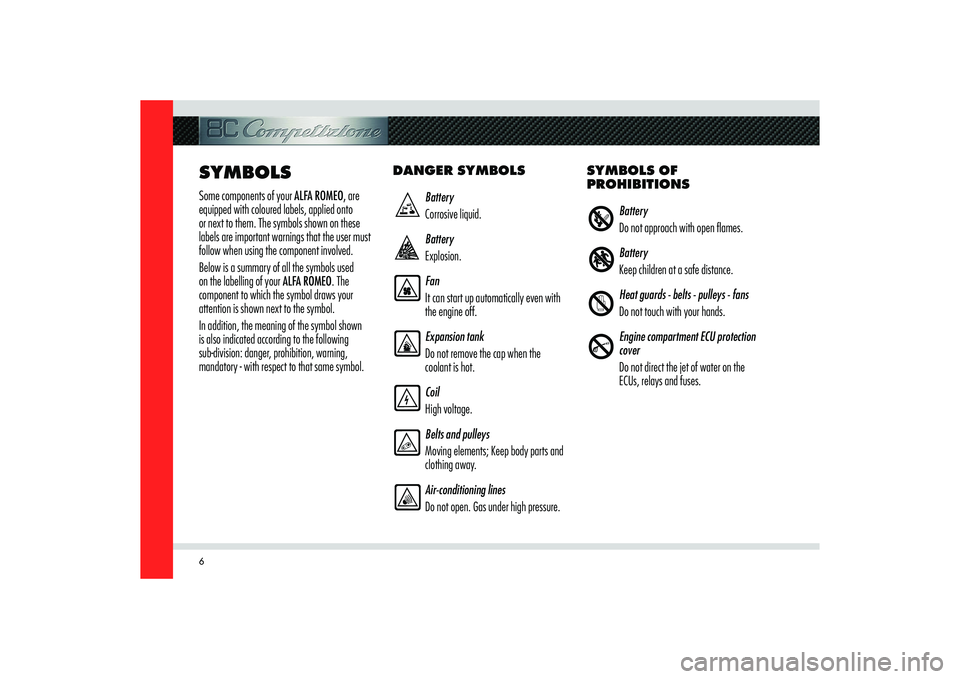
6SYMBOLSSome components of your ALFA ROMEO, are
equipped with coloured labels, applied onto
or next to them. The symbols shown on these
labels are important warnings that the user must
follow when using the component involved.
Below is a summary of all the symbols used
on the labelling of your ALFA ROMEO. The
component to which the symbol draws your
attention is shown next to the symbol.
In addition, the meaning of the symbol shown
is also indicated according to the following
sub-division: danger, prohibition, warning,
mandatory - with respect to that same symbol.DANGER SYMBOLS
Battery
Corrosive liquid.
Battery
Explosion.
Fan
It can start up automatically even with
the engine off.
Expansion tank
Do not remove the cap when the
coolant is hot.
Coil
High voltage.
Belts and pulleys
Moving elements; Keep body parts and
clothing away.
Air-conditioning lines
Do not open. Gas under high pressure.SYMBOLS OF
PROHIBITIONS
Battery
Do not approach with open fl ames.
Battery
Keep children at a safe distance.
Heat guards - belts - pulleys - fans
Do not touch with your hands.
Engine compartment ECU protection
cover
Do not direct the jet of water on the
ECUs, relays and fuses.
Page 9 of 223
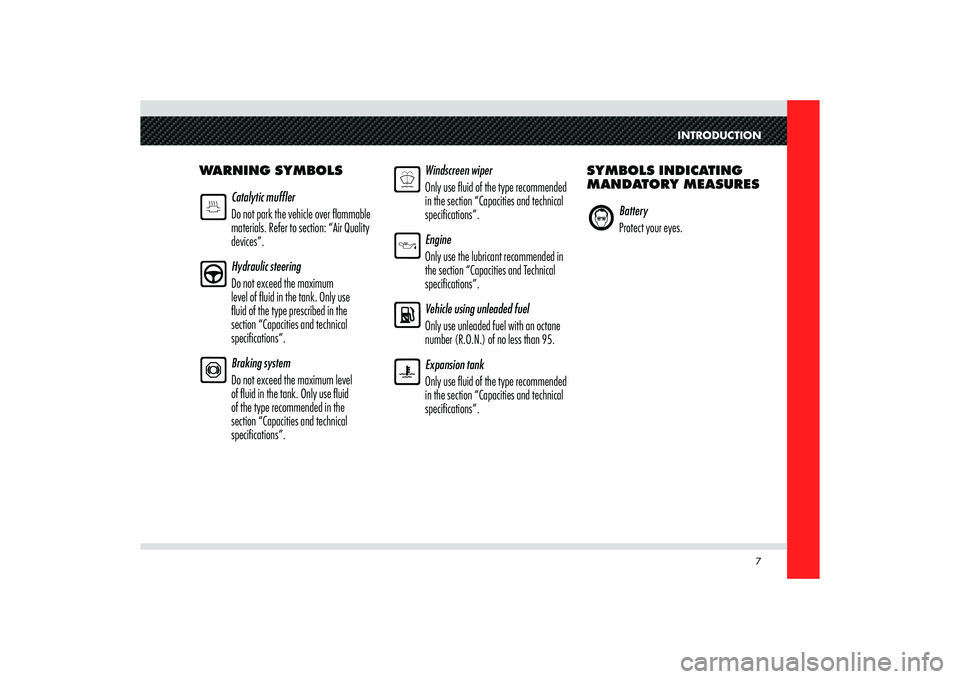
INTRODUCTION
7
WARNING SYMBOLS
Catalytic muffl er
Do not park the vehicle over fl ammable
materials. Refer to section: “Air Quality
devices”.
Hydraulic steering
Do not exceed the maximum
level of fl uid in the tank. Only use
fl uid of the type prescribed in the
section “Capacities and technical
specifi cations”.
Braking system
Do not exceed the maximum level
of fl uid in the tank. Only use fl uid
of the type recommended in the
section “Capacities and technical
specifi cations”.Windscreen wiper
Only use fl uid of the type recommended
in the section “Capacities and technical
specifi cations”.
Engine
Only use the lubricant recommended in
the section “Capacities and Technical
specifi cations”.
Vehicle using unleaded fuel
Only use unleaded fuel with an octane
number (R.O.N.) of no less than 95.
Expansion tank
Only use fl uid of the type recommended
in the section “Capacities and technical
specifi cations”.SYMBOLS INDICATING
MANDATORY MEASURES
Battery
Protect your eyes.
Page 14 of 223
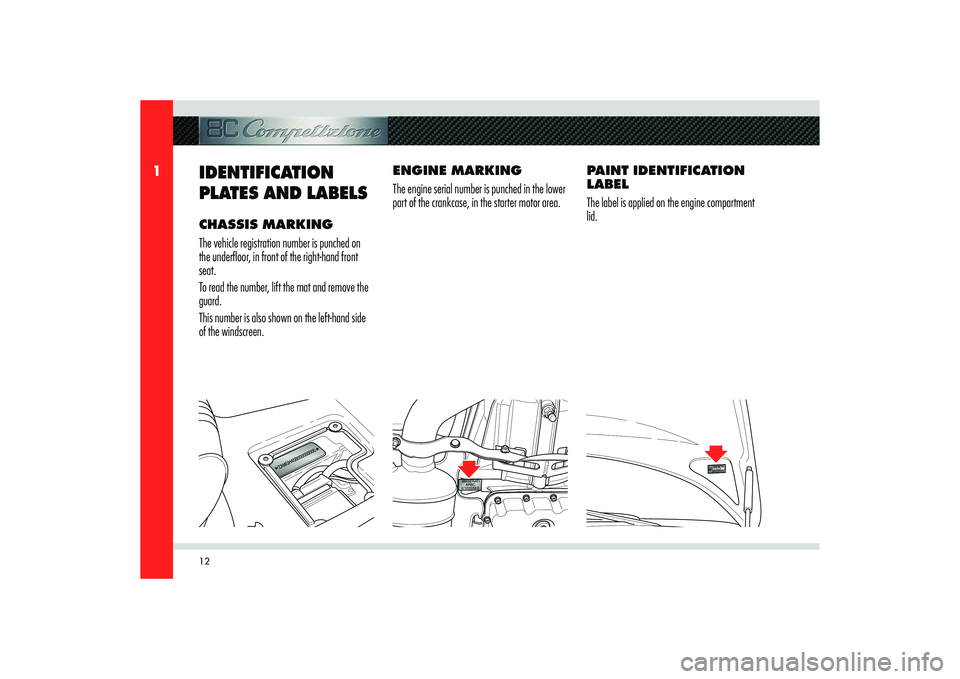
12
1
ENGINE MARKING
The engine serial number is punched in the lower
part of the crankcase, in the starter motor area.
IDENTIFICATION
PLATES AND LABELS CHASSIS MARKING
The vehicle registration number is punched on
the underfl oor, in front of the right-hand front
seat.
To read the number, lift the mat and remove the
guard.
This number is also shown on the left-hand side
of the windscreen.PAINT IDENTIFICATION
LABEL
The label is applied on the engine compartment
lid.
Page 16 of 223
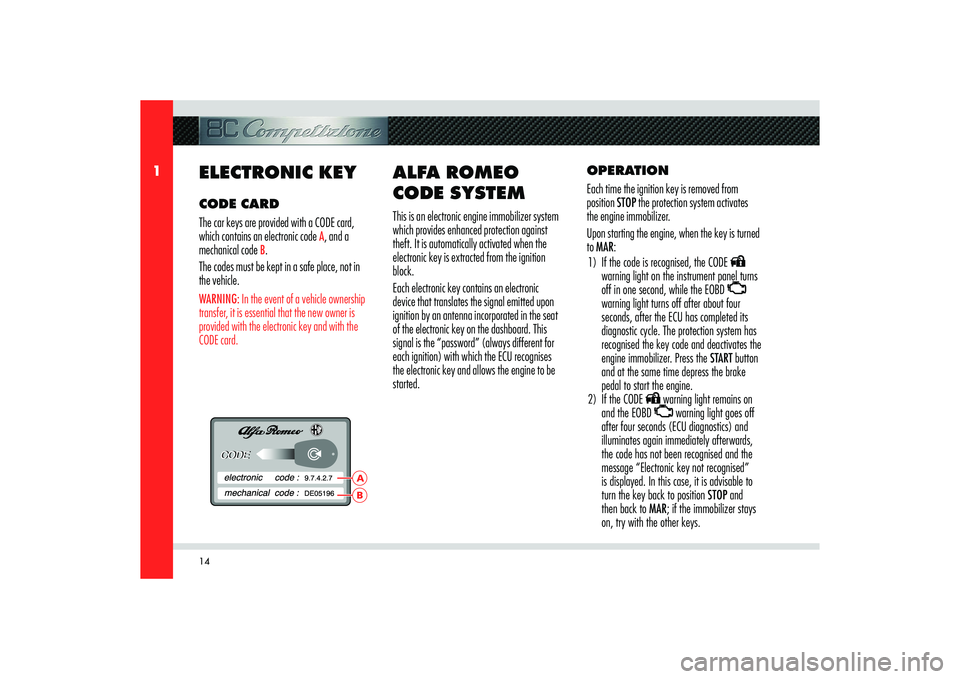
14
1
BA
ELECTRONIC KEYCODE CARD
The car keys are provided with a CODE card,
which contains an electronic code
A, and a
mechanical code
B.
The codes must be kept in a safe place, not in
the vehicle.
WARNING: In the event of a vehicle ownership
transfer, it is essential that the new owner is
provided with the electronic key and with the
CODE card.
ALFA ROMEO
CODE SYSTEMThis is an electronic engine immobilizer system
which provides enhanced protection against
theft. It is automatically activated when the
electronic key is extracted from the ignition
block.
Each electronic key contains an electronic
device that translates the signal emitted upon
ignition by an antenna incorporated in the seat
of the electronic key on the dashboard. This
signal is the “password” (always different for
each ignition) with which the ECU recognises
the electronic key and allows the engine to be
started.OPERATION
Each time the ignition key is removed from
position STOP the protection system activates
the engine immobilizer.
Upon starting the engine, when the key is turned
to MAR:
1) If the code is recognised, the CODE
warning light on the instrument panel turns
off in one second, while the EOBD
warning light turns off after about four
seconds, after the ECU has completed its
diagnostic cycle. The protection system has
recognised the key code and deactivates the
engine immobilizer. Press the START button
and at the same time depress the brake
pedal to start the engine.
2) If the CODE warning light remains on
and the EOBD warning light goes off
after four seconds (ECU diagnostics) and
illuminates again immediately afterwards,
the code has not been recognised and the
message “Electronic key not recognised”
is displayed. In this case, it is advisable to
turn the key back to position STOP and
then back to MAR; if the immobilizer stays
on, try with the other keys.
Page 17 of 223
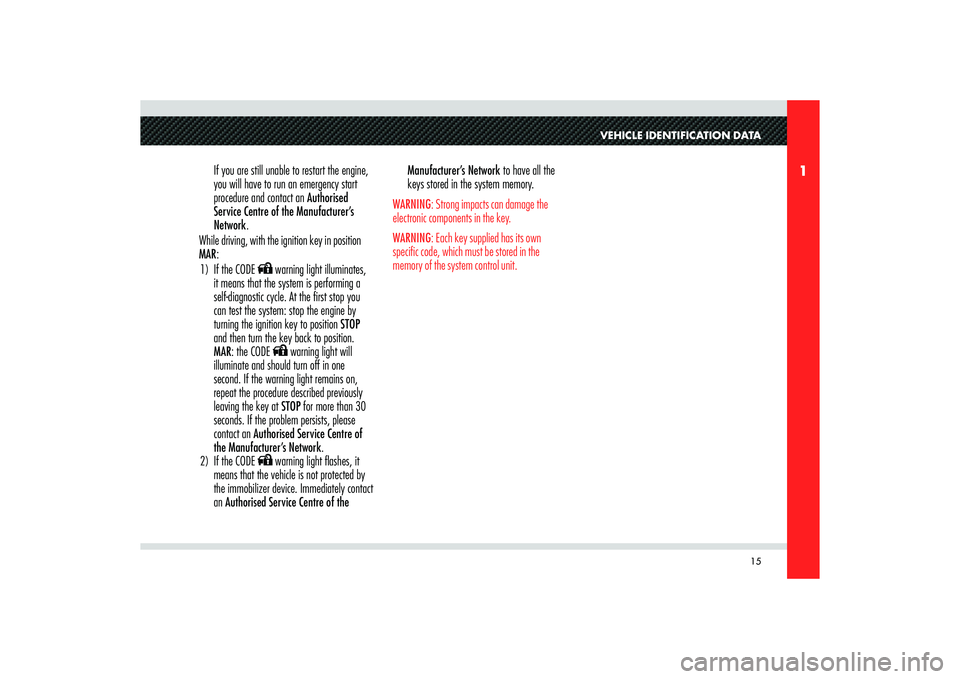
15
1
VEHICLE IDENTIFICATION DATA
If you are still unable to restart the engine,
you will have to run an emergency start
procedure and contact an Authorised
Service Centre of the Manufacturer’s
Network.
While driving, with the ignition key in position
MAR:
1) If the CODE
warning light illuminates,
it means that the system is performing a
self-diagnostic cycle. At the fi rst stop you
can test the system: stop the engine by
turning the ignition key to position STOP
and then turn the key back to position.
MAR: the CODE warning light will
illuminate and should turn off in one
second. If the warning light remains on,
repeat the procedure described previously
leaving the key at STOP for more than 30
seconds. If the problem persists, please
contact an Authorised Service Centre of
the Manufacturer’s Network.
2) If the CODE warning light fl ashes, it
means that the vehicle is not protected by
the immobilizer device. Immediately contact
an Authorised Service Centre of the Manufacturer’s Network to have all the
keys stored in the system memory.
WARNING: Strong impacts can damage the
electronic components in the key.
WARNING: Each key supplied has its own
specifi c code, which must be stored in the
memory of the system control unit.
Page 34 of 223
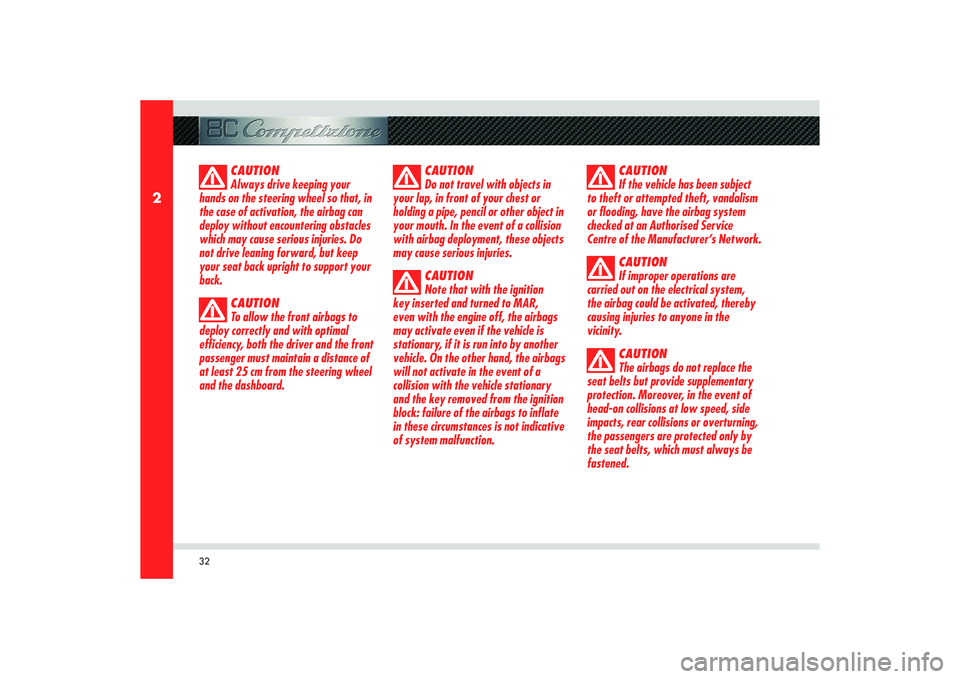
32
2
CAUTION
Always drive keeping your
hands on the steering wheel so that, in
the case of activation, the airbag can
deploy without encountering obstacles
which may cause serious injuries. Do
not drive leaning forward, but keep
your seat back upright to support your
back.
CAUTION
To allow the front airbags to
deploy correctly and with optimal
efficiency, both the driver and the front
passenger must maintain a distance of
at least 25 cm from the steering wheel
and the dashboard.
CAUTION
Do not travel with objects in
your lap, in front of your chest or
holding a pipe, pencil or other object in
your mouth. In the event of a collision
with airbag deployment, these objects
may cause serious injuries.
CAUTION
Note that with the ignition
key inserted and turned to MAR,
even with the engine off, the airbags
may activate even if the vehicle is
stationary, if it is run into by another
vehicle. On the other hand, the airbags
will not activate in the event of a
collision with the vehicle stationary
and the key removed from the ignition
block: failure of the airbags to inflate
in these circumstances is not indicative
of system malfunction.CAUTION
If the vehicle has been subject
to theft or attempted theft, vandalism
or flooding, have the airbag system
checked at an Authorised Service
Centre of the Manufacturer’s Network.
CAUTION
If improper operations are
carried out on the electrical system,
the airbag could be activated, thereby
causing injuries to anyone in the
vicinity.
CAUTION
The airbags do not replace the
seat belts but provide supplementary
protection. Moreover, in the event of
head-on collisions at low speed, side
impacts, rear collisions or overturning,
the passengers are protected only by
the seat belts, which must always be
fastened.
Page 35 of 223
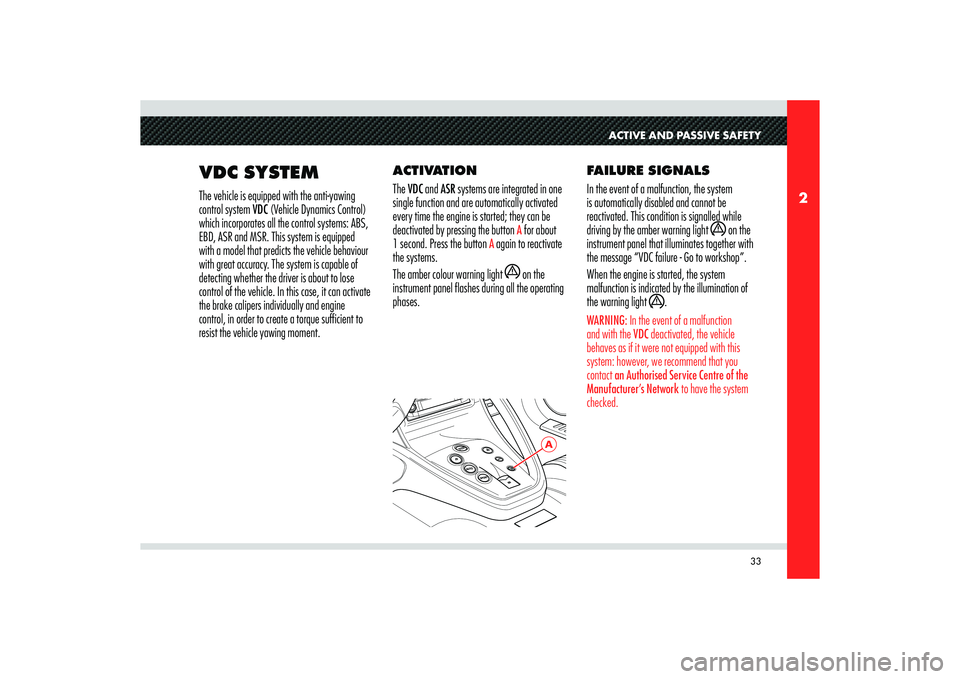
33
2
A
ACTIVE AND PASSIVE SAFETY
VDC SYSTEMThe vehicle is equipped with the anti-yawing
control system VDC (Vehicle Dynamics Control)
which incorporates all the control systems: ABS,
EBD, ASR and MSR. This system is equipped
with a model that predicts the vehicle behaviour
with great accuracy. The system is capable of
detecting whether the driver is about to lose
control of the vehicle. In this case, it can activate
the brake calipers individually and engine
control, in order to create a torque sufficient to
resist the vehicle yawing moment.ACTIVATION
The VDC and ASR systems are integrated in one
single function and are automatically activated
every time the engine is started; they can be
deactivated by pressing the button
A for about
1 second. Press the button
A again to reactivate
the systems.
The amber colour warning light
on the
instrument panel flashes during all the operating
phases.FAILURE SIGNALS
In the event of a malfunction, the system
is automatically disabled and cannot be
reactivated. This condition is signalled while
driving by the amber warning light on the
instrument panel that illuminates together with
the message “VDC failure - Go to workshop”.
When the engine is started, the system
malfunction is indicated by the illumination of
the warning light .
WARNING: In the event of a malfunction
and with the VDC deactivated, the vehicle
behaves as if it were not equipped with this
system: however, we recommend that you
contact an Authorised Service Centre of the
Manufacturer’s Network to have the system
checked.
Page 36 of 223
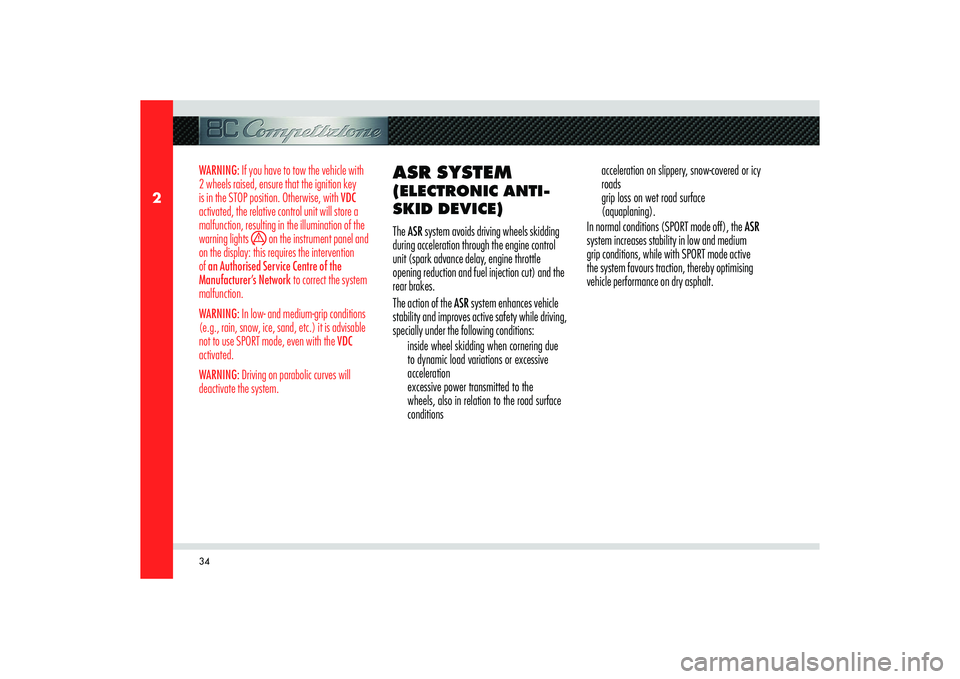
34
2
WARNING: If you have to tow the vehicle with
2 wheels raised, ensure that the ignition key
is in the STOP position. Otherwise, with VDC
activated, the relative control unit will store a
malfunction, resulting in the illumination of the
warning lights
on the instrument panel and
on the display: this requires the intervention
of an Authorised Service Centre of the
Manufacturer’s Network to correct the system
malfunction.
WARNING: In low- and medium-grip conditions
(e.g., rain, snow, ice, sand, etc.) it is advisable
not to use SPORT mode, even with the VDC
activated.
WARNING: Driving on parabolic curves will
deactivate the system.
ASR SYSTEM (ELECTRONIC ANTI-
SKID DEVICE)The ASR system avoids driving wheels skidding
during acceleration through the engine control
unit (spark advance delay, engine throttle
opening reduction and fuel injection cut) and the
rear brakes.
The action of the ASR system enhances vehicle
stability and improves active safety while driving,
specially under the following conditions:
inside wheel skidding when cornering due
to dynamic load variations or excessive
acceleration
excessive power transmitted to the
wheels, also in relation to the road surface
conditions acceleration on slippery, snow-covered or icy
roads
grip loss on wet road surface
(aquaplaning).
In normal conditions (SPORT mode off), the ASR
system increases stability in low and medium
grip conditions, while with SPORT mode active
the system favours traction, thereby optimising
vehicle performance on dry asphalt.